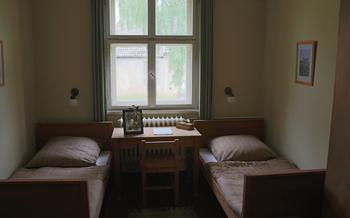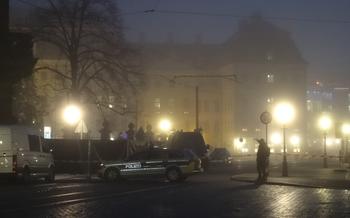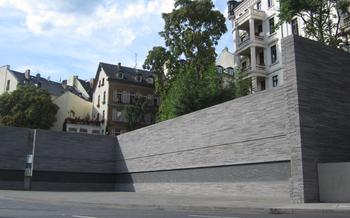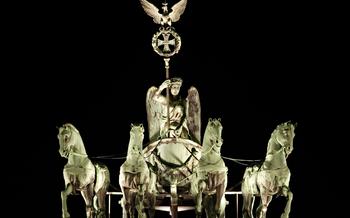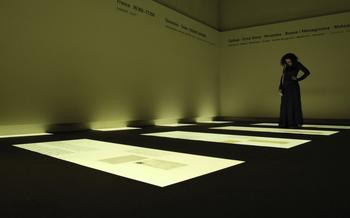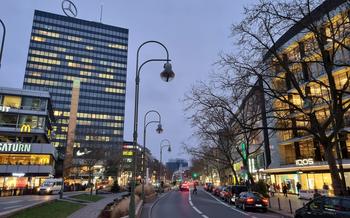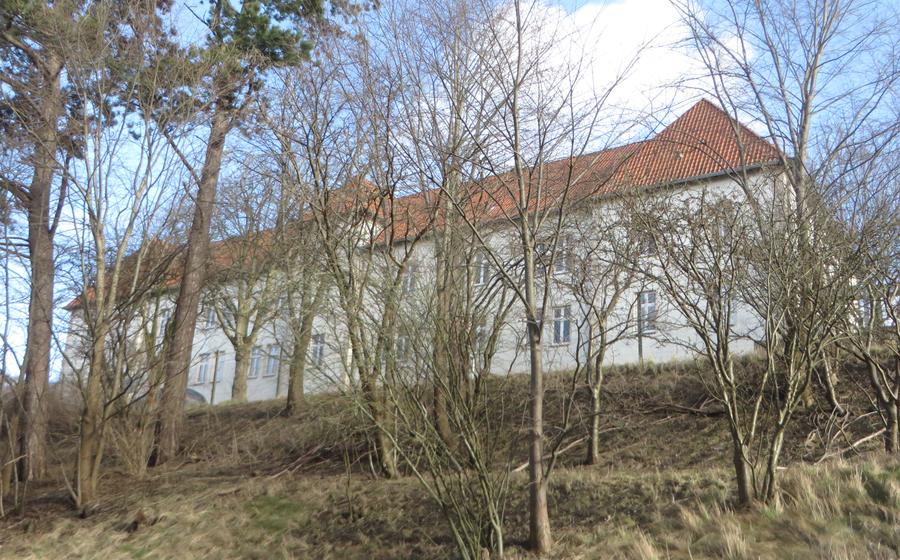
Frøslev Camp Museum
- Location and Accessibility
- Powerful Exhibitions
- Emotional Memorial Site
- Personal Stories: Voices from the Past
- Educational Opportunities
- Research and Documentation
- Preservation of Historical Sites
- Changing Perceptions
- Local Connections
- Cultural Significance
- International Collaboration
- Future Plans
- Insider Tip
Location and Accessibility
Frøslev Camp Museum is situated in the municipality of Padborg, just a few kilometers from the Danish-German border. Its proximity to the border makes it easily accessible for visitors from both countries. The museum can be reached by car, taking the E45 highway and exiting at Padborg. Ample parking is available on-site.
For those traveling by public transportation, the nearest train station is in Padborg, with frequent connections to major cities in Denmark. From the train station, visitors can take a short bus ride or a 20-minute walk to the museum.
Guided tours of the museum are available in Danish, German, and English, providing visitors with a deeper insight into the camp's history and significance. Visitors can also explore the museum independently with the help of audio guides and informative signs throughout the grounds. The museum is wheelchair accessible, ensuring that all visitors can access its exhibitions and facilities.
Powerful Exhibitions
The Frøslev Camp Museum houses a series of powerful exhibitions that delve into the camp's history and the experiences of its prisoners. Permanent exhibitions showcase artifacts, personal stories, and historical documents that provide a comprehensive overview of the camp's operation. Thematic exhibitions focus on specific aspects of the camp's history, such as the role of women in the resistance movement or the impact of the camp on the local population. Interactive displays and multimedia presentations offer visitors a deeper understanding of the camp's significance and the lives of its inmates. The museum also offers educational programs and resources for students and researchers, fostering a deeper understanding of the past and its relevance to contemporary society.
Emotional Memorial Site
The Frøslev Camp Museum serves as a poignant memorial site, commemorating the victims of Nazi persecution and honoring their memory. Throughout the year, remembrance ceremonies and events are held to pay tribute to those who suffered and lost their lives. Visitors have the opportunity to pay their respects, reflect on the past, and gain a deeper understanding of the horrors that transpired within the camp's walls.
The museum features several memorials and sculptures that serve as a lasting tribute to the victims. These memorials, often created by former prisoners or their families, symbolize resistance, resilience, and the enduring legacy of those who were unjustly imprisoned.
By visiting the Frøslev Camp Museum, individuals can not only learn about the atrocities committed during World War II but also pay their respects to the victims and reflect on the importance of remembrance, reconciliation, and the fight against all forms of oppression.
Personal Stories: Voices from the Past
Beyond the historical overview and statistics, the Frøslev Camp Museum brings the past to life through the personal stories of individual prisoners. Letters, diaries, and photographs offer a glimpse into their lives, revealing their hopes, fears, and experiences. Oral histories and interviews with survivors and witnesses provide a human dimension to the camp's history, allowing visitors to connect with the individuals behind the numbers. These personal accounts offer a powerful reminder of the human cost of war and oppression, shedding light on the resilience and suffering of those who endured the camp's harsh conditions.
Educational Opportunities
The Frøslev Camp Museum offers a wide range of educational opportunities for visitors of all ages. Workshops and seminars are regularly held to explore the history of the camp and its significance in greater depth. Educational materials and resources are provided for teachers and students to facilitate learning about the past. The museum collaborates with schools and universities to promote critical thinking and discussions about human rights and social justice. Through these initiatives, the museum encourages visitors to confront uncomfortable truths and reflect on the consequences of prejudice and intolerance, fostering a more inclusive and informed society.
Research and Documentation
The Frøslev Camp Museum serves as a vital center for research and documentation related to the camp and its historical significance. It houses an extensive archive of documents, artifacts, and personal accounts that provide valuable insights into the experiences of prisoners, the camp's operation, and its wider historical context. Researchers, historians, and students have access to these resources, enabling them to conduct in-depth studies and contribute to a deeper understanding of this dark chapter in history.
The museum collaborates closely with academic institutions, historical societies, and other research organizations to facilitate and support scholarly work. It actively participates in conferences, workshops, and seminars, sharing its knowledge and expertise with the broader research community. By providing access to its archives and fostering collaborative partnerships, the Frøslev Camp Museum plays a crucial role in preserving and disseminating historical knowledge, ensuring that the lessons of the past are not forgotten.
Preservation of Historical Sites
The Frøslev Camp Museum is committed to preserving the historical integrity of the camp while ensuring its accessibility for educational purposes. Ongoing efforts are made to maintain and restore the original structures and artifacts, such as the barracks, watchtowers, and barbed wire fences. The museum collaborates with heritage organizations and government agencies to ensure the site's protection and proper management. Striking a balance between preservation and accessibility is crucial, as the museum aims to provide visitors with an authentic and immersive experience while respecting the site's historical significance. By preserving the camp's physical remains, the museum contributes to the collective memory of this dark chapter in history and ensures that future generations can learn from the past.
Changing Perceptions
The Frøslev Camp Museum plays a crucial role in challenging historical narratives and promoting a deeper understanding of the past. It encourages visitors to confront uncomfortable truths and reflect on the consequences of prejudice and intolerance. By presenting a comprehensive and nuanced portrayal of the camp's history, the museum helps to dispel myths and stereotypes, and to foster dialogue and reconciliation among different perspectives. It contributes to a more inclusive and informed society, where historical events are remembered and understood in all their complexity. Through its educational programs, exhibitions, and events, the museum strives to create a space for critical thinking, empathy, and a commitment to human rights and social justice.
Local Connections
The Frøslev Camp Museum fosters strong connections with the local communities and organizations in the region. It actively participates in cultural events and initiatives, supporting local businesses and promoting sustainable tourism. By doing so, the museum strengthens the sense of place and identity in the region, creating a meaningful link between the past and the present. This collaboration benefits both the museum and the local community, as it allows for a deeper understanding and appreciation of the camp's history and its significance for the region.
Cultural Significance
The Frøslev Camp Museum holds a significant place in the cultural heritage of the region and beyond. Recognized for its exceptional historical and educational value, the site has been designated as a protected historical site, ensuring its preservation for future generations. The museum's inclusion in heritage trails and tourism routes further underscores its importance as a destination for cultural and historical exploration. Visitors from around the world come to the museum to learn about the camp's history, pay their respects to the victims, and reflect on the enduring lessons of the past. The museum's exhibitions, memorials, and educational programs contribute to a deeper understanding of the camp's significance, fostering cultural awareness and promoting dialogue about the consequences of prejudice and intolerance.
International Collaboration
The Frøslev Camp Museum actively collaborates with other museums and memorial sites around the world to share knowledge, experiences, and best practices in preserving and presenting difficult histories. These partnerships facilitate the exchange of ideas, research materials, and educational resources, fostering a global network of remembrance and reconciliation.
Through these collaborations, the museum contributes to a deeper understanding of the shared history of persecution and resistance, promoting international dialogue and cooperation. Joint projects and initiatives raise awareness of the camp's significance and its relevance to contemporary issues of human rights, democracy, and social justice.
By working together, the Frøslev Camp Museum and its international partners strive to create a more inclusive and informed global community, dedicated to preserving the memory of the past and promoting peace and understanding for the future.
Future Plans
The Frøslev Camp Museum is continuously evolving to meet the needs of a changing world and to ensure its continued relevance and impact. Future plans include the expansion of the museum's facilities to accommodate new exhibitions and educational programs. The museum is also exploring innovative ways to engage with diverse audiences and present difficult histories in a thought-provoking and accessible manner. Collaborations with artists, scholars, and community groups will play a crucial role in developing new perspectives and creating immersive experiences. The museum remains committed to preserving the memory of the camp and its victims while fostering dialogue and reconciliation on a global scale.
Insider Tip
Make the most of your visit to the Frøslev Camp Museum with these insider tips:
-
Timing is Key: Plan your visit during the summer months, when the weather is pleasant and the surrounding landscape is at its best. The lush greenery and blooming flowers create a serene and contemplative atmosphere that enhances the experience.
-
Immerse Yourself: Allow ample time to explore the museum at your own pace. The powerful exhibitions offer a wealth of information and personal stories, so take the opportunity to delve into the history and truly understand the camp's significance.
-
Guided Insights: Enhance your understanding of the camp's history by joining a guided tour. Led by knowledgeable and passionate guides, these tours provide deeper insights into the camp's operation, the lives of the prisoners, and the broader context of the German occupation of Denmark.
-
Explore the Region: Combine your visit to the Frøslev Camp Museum with other historical sites in the region. The nearby Haderslev Museum offers a fascinating glimpse into the local history and culture, providing a comprehensive understanding of the area's past.
